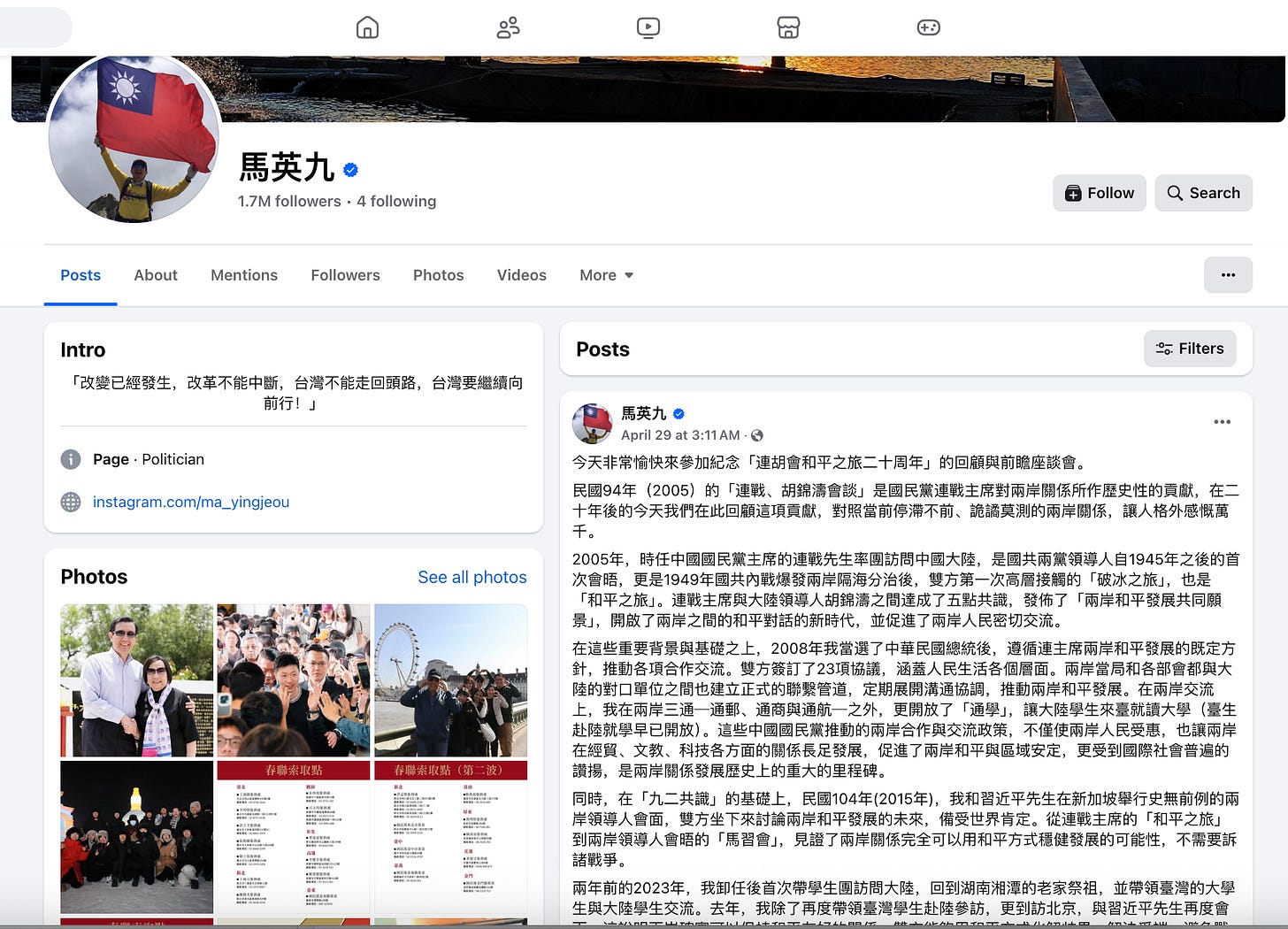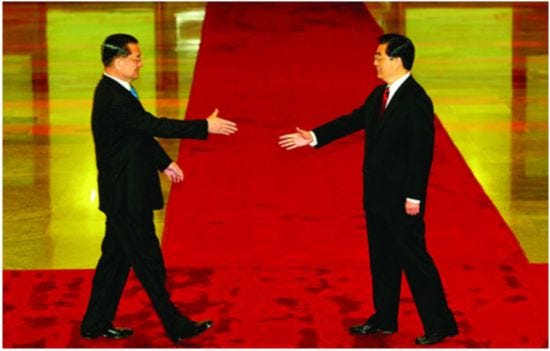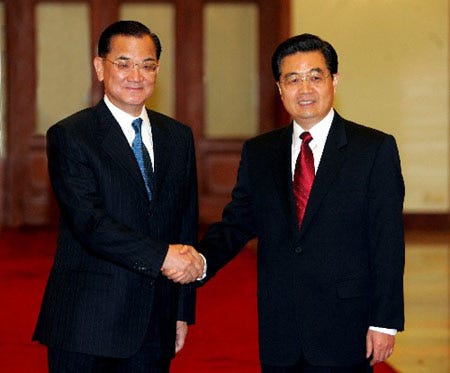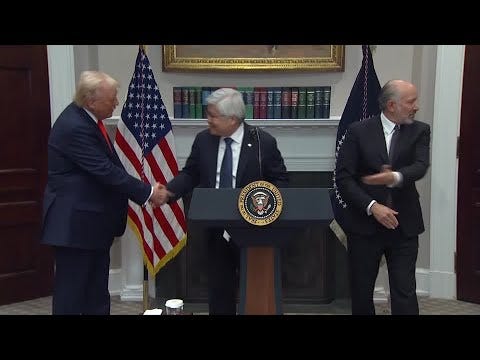Ma Ying-jeou Urges Return to Cross-Strait Dialogue on “Peace Journey” Anniversary
Reflecting on 2 decades since the 2005 meeting in Beijing, the former Taiwan leader calls on William Ching-te Lai to abandon “independence fantasies” and restore peaceful cooperation.
Since I've just covered Ge Jianxiong’s great insight on the unity and division in China’s history, as well as his dissection of the expression “Chinese territory since ancient times,” let’s look at a more current and concrete event.
Ma Ying-jeou, the Kuomintang (KMT) party leader of Taiwan (2008-2016), spoke at the end of last month (April 29, 2025) in a seminar commemorating the 20th anniversary of the “Journey of Peace” and the historic 2005 meeting between Lien Chan and Hu Jintao, the first such meeting between the top leaders of KMT and the Communist Party of China since their civil war.
Ma, whose official title between 2008 and 2016 is the President of the Republic of China (ROC), has posted his remarks on his Meta account
Today, I was very pleased to attend the seminar commemorating the 20th anniversary of the “Journey of Peace” and the historic meeting between Lien Chan and Hu Jintao.
The 2005 meeting between then-Kuomintang (KMT) Chairman Lien Chan and Hu Jintao was a historic contribution by Chairman Lien to cross-Strait relations. Twenty years later, as we look back on that achievement, the contrast with today’s stagnant and unpredictable cross-Strait situation evokes deep reflection and emotion.
In 2005, Mr. Lien Chan, then serving as Chairman of the KMT, led a delegation to visit the Chinese mainland. This marked the first meeting between leaders of the KMT and the Communist Party of China(CPC) since 1945, and the first high-level interaction since the outbreak of the Chinese Civil War in 1949 and the subsequent cross-Strait separation. It was a true “ice-breaking” and “peace-making” journey. During the visit, Chairman Lien and then-leader Hu Jintao reached a five-point consensus and issued the 两岸和平发展共同愿景 “Shared Vision for Cross-Strait Peaceful Development,” opening a new era of peaceful dialogue and fostering closer exchanges between people on both sides of the Strait.
Building upon this important foundation, after I was elected President of the Republic of China in 2008, I followed Chairman Lien’s established policy of cross-Strait peaceful development and promoted a wide range of cooperative exchanges. Both sides signed 23 agreements covering all aspects of people’s daily lives. Formal communication channels were established between respective government agencies and departments across the Strait, facilitating regular dialogue and coordination to promote peaceful development. In addition to opening direct postal, commercial, and transportation links, I also promoted educational exchanges—allowing Chinese mainland students to study at universities in Taiwan (Taiwanese students had long been permitted to study in the mainland). These KMT-led cross-Strait cooperation and exchange initiatives not only benefited the people on both sides, but also significantly advanced relations in trade, education, culture, and science and technology. They helped stabilize cross-Strait peace, contributed to regional stability, and were widely praised by the international community. This marked a major milestone in the history of cross-Strait relations.
Furthermore, based on the 1992 Consensus, in 2015 I met with Mr. Xi Jinping in Singapore—the first-ever meeting between leaders of the two sides. We sat down to discuss the future of cross-Strait peaceful development, and the meeting was widely recognized and applauded around the world. From Chairman Lien’s “Journey of Peace” to the historic “Ma-Xi Meeting,” we have witnessed the very real possibility that cross-Strait relations can develop steadily and peacefully—without resorting to war.
Two years ago in 2023, after leaving office, I led a student delegation to visit the mainland for the first time. We visited my ancestral hometown in Xiangtan, Hunan, and I led Taiwanese university students to engage in exchanges with mainland students. Last year, I again led a student group to the mainland and visited Beijing, where I met once more with Mr. Xi Jinping. These experiences show that peaceful and friendly cross-Strait relations are indeed possible. Both sides are capable of resolving differences and disputes through peaceful means, and of avoiding the calamity of war.
Regrettably, since 2016, when former President Tsai Ing-wen took office, cross-Strait relations entered a period of decline. Combined with disruptions caused by the COVID-19 pandemic, cross-Strait exchanges were virtually suspended for over three years. The Tsai administration’s mishandling of issues—such as the return of mainland Chinese students to Taiwan, including the well-known 小明 “Little Ming” case—only fueled mutual hostility and increased tensions. Now, nearly a year into President Lai Ching-te’s term, not only has he failed to propose any clear or feasible policy to improve cross-Strait relations, but he has instead put forward statements such as the “new two-state theory” and references to “foreign hostile forces.” These views blatantly contradict the constitutional framework of the Republic of China regarding cross-Strait relations and run counter to the long-standing consensus of the two sideson peaceful development. Such statements are shocking and deeply concerning, as they are actively worsening cross-Strait relations and pushing them to the brink. Alongside successive Communist Party of China’s military exercises encircling Taiwan, the peaceful status quo has been virtually destroyed. All of this proves that the Democratic Progressive Party (DPP) government is incapable of managing cross-Strait relations—it has brought no benefits, only mounting problems, and has made innocent Taiwanese citizens bear the consequences.
On this 20th anniversary of Chairman Lien’s “Journey of Peace,” we should reflect on the fact that peace and stability in cross-Strait relations once felt as natural as breathing. During my eight years as President, relations between the two sides were at their best since the 1949 separation. There was no talk of military tension, let alone encirclement drills. Leaders from both sides could meet as equals.
Therefore, I once again call upon President Lai Ching-te: I hope he will act in the interest of all people and abandon the unachievable and unnecessary fantasy of “Taiwan independence”—a path with no future, no external support, no feasibility, and no necesscity. Instead, he should take a pragmatic approach, work steadily from the current situation, and start by improving existing cross-Strait relations. In doing so, he can help safeguard regional peace and stability, and ensure that future generations on both sides of the Strait can live in a peaceful, friendly, cooperative, and prosperous environment.
Of course, this is no easy task. But as the saying goes, “Where there’s a will, there’s a way.” I sincerely hope President Lai will devote himself fully to this worthy and achievable goal.
May God bless Taiwan. May God bless the people on both sides of the Strait. I am looking forward.
News from 2005
两岸和平发展共同愿景
Common Vision for Cross-Strait Peaceful Development
Both parties recognize the following:
Upholding the “1992 Consensus,” opposing “Taiwan independence,” seeking peace and stability across the Taiwan Strait, promoting the development of cross-Strait relations, and safeguarding the interests of compatriots on both sides are shared positions of both parties.
Promoting exchanges and interactions between compatriots on both sides of the Strait and jointly promoting Chinese culture help eliminate misunderstandings, enhance mutual trust, and build consensus.
Peace and development are the prevailing trends of the 21st century. The peaceful development of cross-Strait relations aligns with the common interests of compatriots on both sides and serves the interests of the Asia-Pacific region and the world.
Based on the above understanding, both parties agree to jointly promote the following:
Promote the early resumption of cross-Strait negotiations to jointly seek the well-being of the people on both sides.
Promote the termination of the state of hostility and reach a peace agreement.
Promote comprehensive economic exchanges across the Strait and establish a cross-Strait economic cooperation mechanism.
Promote consultations on issues concerning the participation of the people of Taiwan in international activities.
Establish a regular communication platform between the two parties.
Ma Ying-jeou protests Lai Ching-te, remembers Pope Francis
·Ma Ying-jeou, Taiwan's leader between 2008 and 2016, joined a massive protest organized by his Kuomintang (KMT) Party against William Ching-te Lai, the current leader of the Democratic Progressive Party (DPP), on Saturday, April 26.
Ma Ying-jeou asks William Lai Ching-te to "protect" TSMC
After repeated false claims from President Donald Trump that Taiwan stole chip manufacturing business from the U.S., and Trump’s threat of imposing tariffs between 25 and 100 percent, CC Wei, the Chairman and CEO of Taiwan Semiconductor Manufacturing Co. (TSMC) announced a $100-billion, five-factory investment plan in the U.S.
Ma Ying-jeou's latest speech on cross-Taiwan Strait Relations
Ma Ying-jeou served as the 12th and 13th President of the Republic of China (ROC), or the leader of Taiwan, between 2008 and 2016.
Ge Jianxiong on unity and division in China's history
For those who follow China’s foreign policy, the expression “Chinese territory since ancient times" is likely a familiar term. Yesterday, I shared, in The East is Read, part of an essay written 26 years ago by Ge Jianxiong on the subject.










Ma Ying-jeou is pretty irrelevant in Taiwan today, even in his own political party. So it's difficult to understand why he is given so much space, repeatedly, in this newsletter.